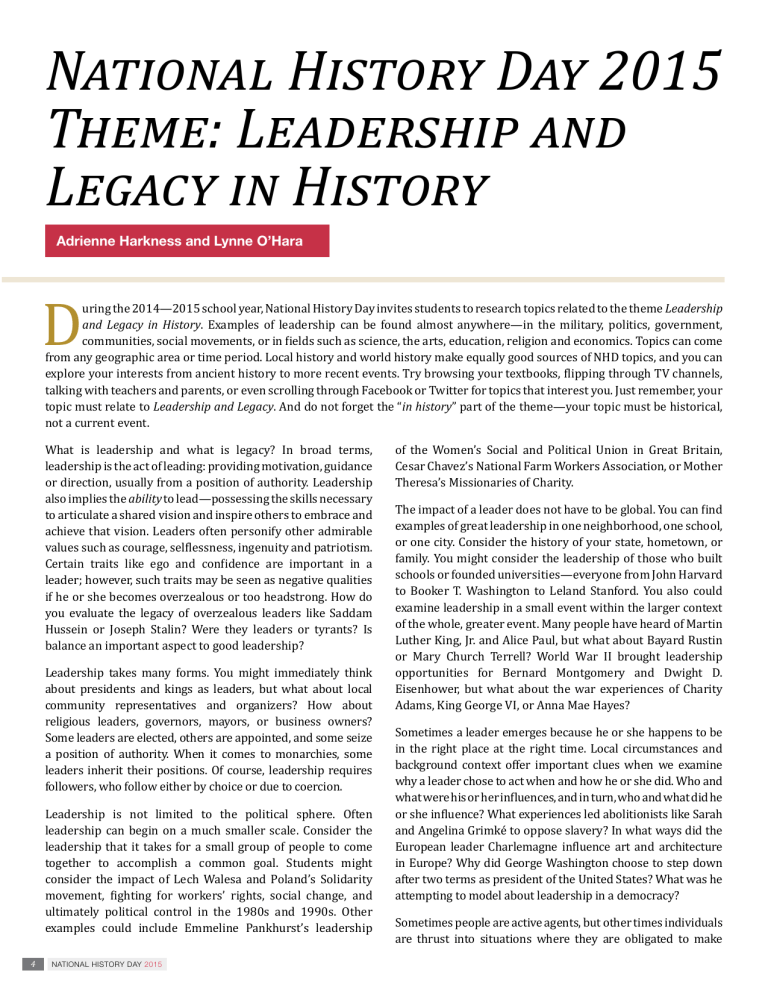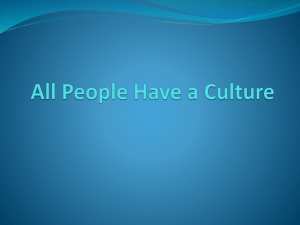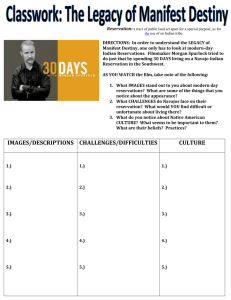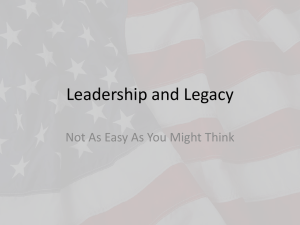D National History Day 2015 Theme: Leadership and Legacy in History

National History Day 2015
Theme: Leadership and
Legacy in History
Adrienne Harkness and Lynne O’Hara
4
D uring the 2014—2015 school year, National History Day invites students to research topics related to the theme Leadership
and Legacy in History. Examples of leadership can be found almost anywhere—in the military, politics, government, communities, social movements, or in fields such as science, the arts, education, religion and economics. Topics can come from any geographic area or time period. Local history and world history make equally good sources of NHD topics, and you can explore your interests from ancient history to more recent events. Try browsing your textbooks, flipping through TV channels, talking with teachers and parents, or even scrolling through Facebook or Twitter for topics that interest you. Just remember, your topic must relate to Leadership and Legacy. And do not forget the “in history” part of the theme—your topic must be historical, not a current event.
What is leadership and what is legacy? In broad terms, leadership is the act of leading: providing motivation, guidance or direction, usually from a position of authority. Leadership also implies the ability to lead—possessing the skills necessary to articulate a shared vision and inspire others to embrace and achieve that vision. Leaders often personify other admirable values such as courage, selflessness, ingenuity and patriotism.
Certain traits like ego and confidence are important in a leader; however, such traits may be seen as negative qualities if he or she becomes overzealous or too headstrong. How do you evaluate the legacy of overzealous leaders like Saddam
Hussein or Joseph Stalin? Were they leaders or tyrants? Is balance an important aspect to good leadership?
Leadership takes many forms. You might immediately think about presidents and kings as leaders, but what about local community representatives and organizers? How about religious leaders, governors, mayors, or business owners?
Some leaders are elected, others are appointed, and some seize a position of authority. When it comes to monarchies, some leaders inherit their positions. Of course, leadership requires followers, who follow either by choice or due to coercion.
Leadership is not limited to the political sphere. Often leadership can begin on a much smaller scale. Consider the leadership that it takes for a small group of people to come together to accomplish a common goal. Students might consider the impact of Lech Walesa and Poland’s Solidarity movement, fighting for workers’ rights, social change, and ultimately political control in the 1980s and 1990s. Other examples could include Emmeline Pankhurst’s leadership of the Women’s Social and Political Union in Great Britain,
Cesar Chavez’s National Farm Workers Association, or Mother
Theresa’s Missionaries of Charity.
The impact of a leader does not have to be global. You can find examples of great leadership in one neighborhood, one school, or one city. Consider the history of your state, hometown, or family. You might consider the leadership of those who built schools or founded universities—everyone from John Harvard to Booker T. Washington to Leland Stanford. You also could examine leadership in a small event within the larger context of the whole, greater event. Many people have heard of Martin
Luther King, Jr. and Alice Paul, but what about Bayard Rustin or Mary Church Terrell? World War II brought leadership opportunities for Bernard Montgomery and Dwight D.
Eisenhower, but what about the war experiences of Charity
Adams, King George VI, or Anna Mae Hayes?
Sometimes a leader emerges because he or she happens to be in the right place at the right time. Local circumstances and background context offer important clues when we examine why a leader chose to act when and how he or she did. Who and what were his or her influences, and in turn, who and what did he or she influence? What experiences led abolitionists like Sarah and Angelina Grimké to oppose slavery? In what ways did the
European leader Charlemagne influence art and architecture in Europe? Why did George Washington choose to step down after two terms as president of the United States? What was he attempting to model about leadership in a democracy?
Sometimes people are active agents, but other times individuals are thrust into situations where they are obligated to make
NATIONAL HISTORY DAY 2015
choices and act. Reactions to a social event, a natural disaster, an oppressive government, or other situation often show leadership. In wartime, many people find themselves forced by circumstances to do things they could never have imagined.
Consider British, French, German, and American soldiers on the front lines of World War I. There are many examples where leaders have emerged unexpectedly. During the Normandy campaign in World War II, General Theodore Roosevelt, Jr. (the son of the president) landed with his infantry battalion on Utah
Beach, more than a mile away from his intended location. He is famously quoted as saying “We’ll start the war from right here!”
How did his leadership make a difference?
L eaders often arise because they have new ideas about how something should be done or redone, built or rebuilt. They see a situation and want to change it, convinced that their vision will improve an element of life or change their community for the better. Consider great American entrepreneurs that historian H.W. Brands labeled as “masters of enterprise”—leaders such as Roy Kroc, Bill Gates, Mary Kay Ash, Cornelius Vanderbilt, or John Rockefeller. Leaders dare to ask difficult questions and are passionate about resolving issues.
Of course, not all first ideas are good ones. A leader and his or her supporters may revise and change ideas in the process of moving toward a goal. This is particularly evident when they run into obstacles. Leaders like Mahatma Gandhi, Nelson
Mandela, and Ellen Johnson Sirleaf were forced to make adjustments on their path to leadership. As leaders they pushed through challenging situations, and found solutions to overcome the hurdles in their way. Can other leaders, or even followers, become obstacles?
Looking carefully at the impact on society and change over time, you will also need to think about the leader’s legacy.
Legacy is what is handed down to us from our ancestors or predecessors. More broadly, legacy is what is left behind for future generations—such as ideas and accomplishments.
Legacies sometimes cannot be understood until long after a leader has passed away. Often reformers were considered radicals in their time. Abolitionists, socialists, anarchists, and civil rights activists around the world have seen changes in the world. What change or objective did they set in motion? How did they set out to change the world? Did they succeed? What are the legacies of John Brown, Guy Fawkes, or Karl Marx?
Sometimes a legacy depends on perspective. Not all legacies are positive ones. What happens when leadership goes awry? Legacies also can be controversial. Events can lead one group of people to feel that a leader was a great and moral influence who facilitated a positive outcome, while a different group of people believe exactly the opposite. Consider the history of Martin Luther, Sir Thomas More, Francisco Franco, the Irish Republican Army, or the Palestine Liberation
Organization. Examining both sides of the story is important to understanding your topic.
It often happens that new leaders pick up where previous leaders left off, which also adds to the legacy. Followers and supporters will frequently carry the torch, moving forward and working together to maintain the pursuit or accomplish the goal. What role did Bella Abzug, Gloria Steinem, and Lilly
Ledbetter play in the 20 th -century feminist movement? How can the tragic death of a leader like Mahatma Gandhi, Robert
Kennedy, or Benazir Bhutto inspire others to continue the fight for their political, social, or economic goals?
How important is the relationship between a leader and supporters or followers? Great leaders typically have a great network of supporters. These people agree with what the leader stands for and play a part in helping him or her succeed.
Mao Zedong led a massive revolution in China. Why did it succeed? How did he use his leadership to convince people to follow him? Followers are inspired by the leader and feel a sense of duty to the cause. Some supporters, of course, are faithful to a leader no matter what questionable actions he may take. Do you see examples of followers turning a blind eye to certain events because of their extreme loyalty?
When leadership goes awry, leaders can become destroyers. There are instances throughout history where leaders abused their power.
Are there differences in leadership strategies for a destroyer? And can a follower or supporter influence the destruction? Consider the leadership of Nero in ancient Rome, Mobutu Sese Seko in the
Congo, or Mohammad Reza Pahlavi in Iran. Are other nations responsible for removing leaders from power?
Just because something happened and someone did something, however, it does not necessarily mean a legacy was created. The key is to think about a leader’s significance in history. So what? Does this person really matter? Was there real change that occurred because of his or her leadership?
What was the impact on people, society, economics, or government? How did it affect what people thought or did, or maybe how people think or act today? Consider both the short-term and long-term impact. Remember that examining the context and historical significance of your topic is a crucial part of the research process that also will help you strengthen and support your thesis.
In considering the theme Leadership and Legacy in History, keep in mind that it is important to address both elements.
Highlighting both the leadership and the legacy of your chosen subject will help you clearly explain the relation of your topic to the theme. Successful researchers look at available primary and secondary sources and draw conclusions from the information. Your analysis of the evidence and presentation of the information to support your thesis is a critical part of your project. Use these primary sources and let the individuals speak for themselves. In thinking about your topic, ask yourself, “what is so important about my topic and what do
I want people to understand after viewing my project?” Your answers to these key questions will help guide you as you decide how to present your information.
NATIONAL HISTORY DAY 2015 5




